Chevy makes Trax to fill compact SUV segment
Filed under: Weekly test drives, Autos
By John Gilbert
If you are a cynic, or a hard-core traditionalist, you might view the Chevrolet Trax with some degree of scorn. I mean, for comparison sake, you have the Suburban, Tahoe, Equinox, Traverse, and assorted sizes of pickup trucks, and next to them, the Trax seems almost toy-like.
In that frame of mind, you might look with careful scrutiny to find things that are objectionable about the Trax, which is Chevrolet’s smallest, lightest, and probably least-haul vehicle. And yes, it’s inexpensive, in the mid-$20,000 range, but it’s got a tiny engine, so what good is it?
However, in real life you can try to find fault in the size, but once you climb inside you find that there is a surprisingly adequate amount of room, both in the front buckets and the rear seats. It doesn’t seem that anything that compact on the outside can be that roomy inside.
You can’t find fault with the instrument layout or the fit and finish of the dashboard or controls. In fact, they all seem laid out to perfection.
And when it comes to design, the Trax looks good from the front, especially with that little ring of LED driving lights that outline the headlight enclosures. It looks good from the rear, with a nicely proportioned taper to the hatchback and rear corners, as they slope upward toward the roof.
It also looks good in silhouette, rounded off nicely and proportioned just right all along the lines that sweep from stem to stern.
The Trax is the brainchild of General Motors when it went over to South Korea and bought out the Daewoo factory, which had made stylish but marginal cars that were faltering in the marketplace, particularly alongside such outfits as Hyundai and Kia.
The first Trax caught my attention, because I have always thought that any vehicle that’s big enough needn’t be bigger, and unless you have to haul a heavy trailer around, or make frequent trips with half a dozen or so occupants, then anything bigger than big enough is too big. Why should we haul around excess weight?
So the latest trend toward compact crossover SUVs was instantly appealing to me, and I appreciate nearly all of the dozens of downsized, economical and agile performers amid the sea of crossover vehicles. But the Trax still is mind-blowing when it takes its place in Chevrolet’s arsenal of medium to enormous SUVs.
 Then along comes the 2017 model year, and Chevrolet redesigns the Trax. It’s not an all-car, but what they cal“refreshed” in the industry. Meaning the corners might be rounded off, the contours tweaked just a bit, and everything sort of tightened up.
Then along comes the 2017 model year, and Chevrolet redesigns the Trax. It’s not an all-car, but what they cal“refreshed” in the industry. Meaning the corners might be rounded off, the contours tweaked just a bit, and everything sort of tightened up.
In the process, Chevrolet also upgraded the interior considerably, and what might have seemed a bit tacky in the original is now nicely padded and soft to the touch, as well as fitting together better.
Under the hood, there beats a 1.4-liter 4-cylinder engine with a turbocharger mounted, for crying out loud. There is no optional engine, but the Trax doesn’t need one. Chevrolet seems to have connected on the perfect group-think in plotting out the engine that will make the Trax perform the best, in either front-wheel drive or the all-wheel drive that folks in the snow-belt or who might face some foul weather should demand.
I had the chance to spend a week with a gleaming white Trax, and I thought it looked good in all circumstances. It also performed well on a freeway trip, and delivered fuel economy in the high 20s. EPA estimates range into the 30s, in fact, and you might reach the estimated 34 if you stayed under 65 or 70.
Among the new features are a Premier trim level, which offers larger 18-inch wheels with your all-season tires, and Apple CarPlay or Android Auto are now compatible, boosting the Trax to the properly high level of connectivity.
Lane departure warning and forward collision alert are now available, too, and, going back to the cynical big-truck guys, there can be no faulting the quickness of acceleration or the quick response of the steering, which is well-coordinated with the suspension.
There is no recommended towing capacity for the Trax, although you might get away with a light fishing boat or extra light camping trailer with the AWD models.
Trax continues to be a made-in-Korea vehicle, which is not an issue for anyone this side of our new president. And for anyone who has driven anything by Hyundai or Kia in recent years, we won’t question the technology or quality control of the Trax.
In fact, there are reports that the Trax has made its own impact on the new smaller compact-crossover segment by becoming the vehicle with a Chevrolet bow-tie emblem that is sold to the largest percentage of female buyers. Some estimates range as high as 60 percent female buyers, in fact, proving that women might be wiser than some of those cynical, macho types who think trucks have to be huge, hefty, poor in fuel efficiency, and twice as expensive as the basic $22,000 Trax.
The facts that it’s highly maneuverable, quick, attractive, and with all the improvements packed into the 2017 model make it worth evaluation for anyone looking for the security of weather-worthy AWD in a contemporary and high-style Trax.
CR-V adds turbo power to stay on top
Filed under: Weekly test drives, Autos, Uncategorized
By John Gilbert
If you know folks who own a Honda CR-V, chances are they love it. And, chances are it might be four or five years old, or older, and they still love it.
The CR-V has been an enduring vehicle for Honda, helping establish the trend toward compact SUVs, which proved immensely popular when gasoline was expensive, and have continued their upsurge in popularity even when gasoline became cheap.
With the new 2017 CR-V, Honda has made so many changes that its left even popular auto magazines in the distance. Take Motor Trend, for example. That magazine runs annual editions that run little capsule descriptions of all the new cars, trucks, and SUVs. It is very helpful if you’re looking at buying a new vehicle, because it helps with the research and cuts down the usual comparison shopping chore.
That issue came out last October. In its capsules, it ran pieces on the all-new Ridgeline, the Pilot, the Odyssey van, the HR-V, and the CR-V. Under CR-V, it says: “The CR-V remains unchanged. All CR-Vs are powered by a 185 horsepower 2.4-liter inline-4…”
I got the chance to spend a week with a new 2017 CR-V, and it was remarkably peppy and handled extremely well, and it had quite a different look to it. Unchanged? I think it is greatly changed.
Believing Motor Trend, I didn’t bother to look under the hood for several days. The CR-V ran well, handling all weather conditions, and seemed to uphold the tradition of being a new halo vehicle for Honda. Finally, I raised the hood. Sure enough, there was no 2.4-liter engine in sight — instead, it was a 1.5-liter 4-cylinder, with a turbocharger hanging onto the engine.
Honda is not new to turbocharging, and in fact has some progressive engineers who have established breakthrough technology with some previous turbos on vehicles such as the Acura RD-X. And Honda has used turbos to extremes while fiddling at the highest echelon of motorsports, places such as the Indianapolis 500 and Formula 1.
Honda had resisted the temptation to add turbochargers to its mainstream production vehicles. Turbos take a stream of exhaust gases that are headed for the tailpipes, and instead channels the flow to spin a generator turbine wheel that, in turn, force-feeds a more potent airflow into the engine’s intake. That air sucks in more fuel, and the result is more power and more efficiency.
The new CR-V, changed quite dramatically, thank you, is also changed under the hood. Instead of a 2.4-liter that produces 185 horsepower, the comparatively tiny 1.5 develops a quite amazing 190 horsepower and 179 foot-pounds of torque, thanks to the turbo.
While it feels light and agile (because it is!), the CR-V also has improved fuel efficiency, up to EPA ratings of 26 miles per gallon city, and 32 mpg in highway driving. All the while feeling quicker and more agile.
Other more subtle tricks include a more aerodynamic shape amplified by an active-shutter grille, which closes at cruising speed, when cooling isn’t needed, to form a barrier against air streaming in.
Honda now has bracketed the CR-V with an all-new larger Pilot, which is a truly full-featured luxury SUV now, and a smaller and more basic HR-V, which I was slightly disappointed in, but only because I was accustomed to the CR-V and the high standards it had set and maintained.
The new CR-V comes in various forms, starting with the LX at a base price of just over $26,000; the EX starting at $26,695; the EX-L (meaning leather upholstery) starting at $29,000; and the Touring model, starting at $32,000. The base LX starts with a front-wheel drive version, which should handled even Duluth type winter driving without difficulty. But the available all-wheel drive is the trick answer, because it is a “real-time” system that transfers torque away from any wheel where any tendency to spin is detected by the sharp-witted computer.
Stressing its safety and creature-feature style, the CR-V has Honda Sensing, which includes a suite of items such as lane-keep assist, collision mitigation, and road-departing mitigation which use computer aided technology to alert you if you wander across a lane-dividing line without signaling, and can be set to gently prevent you from wandering across that lane line.
Honda also has added the trick first developed by Ford for its Escape, where you can walk up to the CR-V from behind, holding your sacks of groceries, and wave your foot under the rear bumper, causing the tailgate to unlatch and open. Very handy.
The interior of the CR-V is upgraded too, although I’d like to make a strong suggestion to Honda to be careful how they “improve” their controls and switchgear.
My favorite feature of all Hondas is that they tend to have ergonomically perfect instruments and controls, meaning that you reach for something and it’s there. Even if you’ve never been in the vehicle, the lights are right where you think they should be, same with the wipers.
In recent model changeovers, however, there seems to be the tendency to make some items a bit more complex. Don’t do that! The CR-V still has logical redundant switches on the steering wheel, and you can pretty well operate everything from there.
Otherwise, you can operate the audio system’s technical complexities via the large navigation screen, which includes touch-screen operation. Personally, I’m not a fan of touch-screens. Seems to me, after three or four days, you need some high-tech stuff to clean the fingerprints off the touch-screen.
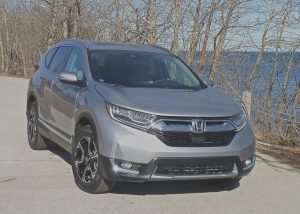
Nothing has changed more than the grille on each CR-V generation, and this time the stylists got it right.
Especially if you’ve stopped by the Great Lakes! Candy Shop in Knife River, and got overly friendly with some of those home-made caramel things. Let’s see you try to make it all the way home without sampling some of the goodies, after which you need some high-test washer fluid to clean the touch-screen.
As for the prices of the CR-V stable, each model offers all the features of the previous model, plus some added stuff. So the prices go up commensurately and each level seems to be a relative bargain. And while the basic LX is in the mid-$20,000 range, the completely loaded Touring model might reach the mid-$30,000 level. My favorite is the EX-L, because I like leather seats, and I’d pay extra for them, as well as the other features that model adds.
And so as not to embarrass anyone at Motor Trend, we’ll keep it a secret as we jump at that 1.5-liter turbo with its CVT, accepting power increases over the 2.4, as well as delivering fuel economy of over 30 mpg on the highway.
Jaguar adds ‘the Jaguar’ of SUVs
Filed under: Weekly test drives, Autos
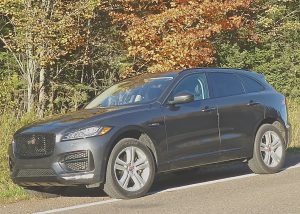
One of the most storied names in sports cars and sedans, Jaguar has jumped into the SUV segment with the F-Pace that gives up nothing in the classy luxury area.
Duluth, MN.
Jaguar. The very name connotes slinky handling and exotic and classy styling. The name does NOT conjure up the image of an off-road truck.
The word “Jaguar” and the term “SUV” do not, on the surface, seem compatible. But only if you have not seen the new Jaguar F-Pace. I got to spend a week test-driving the F-Pace in Northern Minnesota, along with a couple other Jaguar more traditional Jag staples — the XF coupe and the XE sedan
You may have heard that every auto company in the world either has made an SUV or is in the process of making one. This includes the usual suspects of manufacturers that are accustomed to making rugged vehicles. But it also includes some companies that challenge you to believe it now has a legitimate sports-utility vehicle.
The F-Pace is Jaguar’s first attempt at building a world-class SUV, and it is a keeper. It gets a 2.0 turbo-diesel or 3.0 supercharged V6, which can be selected as 380-horse missile. It is fast in a straight line, and it handles…well, like a Jaguar. There’s never been a Jag that didn’t handle well. This just happens to be an SUV.
At about $70,000, the Jaguar F-Pace has a clean and classy silhouette, unencumbered with too many grooves and swoosh styling touches. It won a recent winter-drive competition by Motor Trend, beating the AMG-trim Mercedes GLC and a Porsche Macan GTS in performance — and also, the magazine says, with the most comfortable seats.
Other F-Pace models range from $42,000 to $57,000 for base price, but if you want to hold the price down, stay away from the delectable option bin.
Jaguar is owned, these days, by Tata Motors of India, a big-time auto manufacturer in a country that is rushing to the top of auto-selling, as if pursuing China to become the largest. Within a year or two, those two will be among the top three car-selling nations on the planet.
Maybe we shouldn’t be that surprised; Tata also bought Jag’s British cousin, Land Rover, which makes some of the best-engineered off-road vehicles anywhere. The plan works well, with Range Rovers now boasting Jaguar power and Jaguar undoubtedly benefitting from Land Rover’s off-road expertise.
Duluth, Minnesota, is a city with 90,000 on the Western tip of Lake Superior. Built on the side of a cliff means it has fantastic vistas of every sunrise. Its size also means Duluth doesn’t have the full spectrum of auto dealerships, although the Twin Cities of Minneapolis and St. Paul are only 2 hours away. From my experiences there might be more car-fanciers per capita in Duluth than anywhere else I’ve been.
Every summer, some sort of vintage car show is held somewhere in the Duluth area virtually every weekend. The biggest is the annual Sidewalk Days downtown, when they close off Superior Street to traffic and have all the shops and restaurants take it over. For the first weekend, there is a huge hot rod and vintage car show, with at least a hundred beautifully restored cars lined up on both sides of the street for about six blocks.
As the area’s new car test-driver in residence, I knew I’d have a new car that week last summer, and I was able to park on the street, amid the show cars.
That week I had at my disposal a new Jaguar F-Type coupe. Now, as exotic cars go, we have Ferraris, Lamborghinis, Porsches, Aston Martins, Maseratis, a Lotus or two, and a Mercedes or four. But jolly old England, with its Jaguars, takes a back seat to nobody. To coin a phrase.
The latest edition of the F-Type is a dramatic example of how well a storied old company in Coventry, England, with the right infusion of financial backing, can create a spectacular array of progressive and contemporary exotic cars. Under the ownership of Tata Motors, Jaguar is at the top of its game.view
So there I was, with “my” Jag on Superior Street, right out front of a music and specialty shop where I could watch interested car folks meander by, stopping now and then to look at a 1957 Chevy, or some similar ancient car. But all of them, every single one, stopped in their tracks to gaze at the Jaguar F-Type.
That’s when I felt a little guilty. Those custom and restored cars consumed hundreds of hours and thousands of dollars, and many were prize-winners. But none of them could divert passers-by from stopping to appreciate the Jag.
You can buy the F-Type R-Sport with its optional 5.0-liter V8, supercharged up to 575 horsepower and 516 foot-pounds of torque for just under $130,000. You also can buy it for $62,000, which represents a tremendous bargain with its 3.0-liter supercharged V6 with 340 horsepower and 332 foot-pounds of torque, or tweaked from the factory to 380 horses and 389 foot-pound.
In any form you get fantastic performance, and either a 6-speed manual, or a 6-speed automatic that is operated by a neat little puck-shaped gadget that rises out of the console when you start the car. You also can get it in a convertible.
Stunning as the F-Type is, particularly from the rear corner, where the spectacular tapering roofline is more than just exotic, it is just the hot model of Jaguar’s livery.
Within a few weeks, I got the Jaguar XE sedan. The F-Type is drop-dead gorgeous. The XE sedan came in two forms, the XE 35t Prestige, with the same 340-horse 3.0 supercharged V6, at $46,595, or the XE 20d, with a 2.0-liter turbocharged diesel engine, with 180 horsepower and 318 foot-pounds of torque and all-wheel drive.
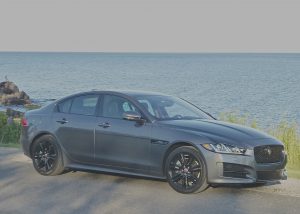
The XE sedan came with a powerful, smooth and economical 2.0-liter turbo-diesel and all-wheel drive.
Yes, an AWD turbo-diesel sedan, with Jaguar flair, at just under $50,000. Diesels have been getting a bad rap lately, but they still perform with great power and can roll up impressive fuel economy figures.
By interesting coincidence, after thoroughly enjoying the drives in all these Jaguars, the timing continued to be fortunate. Another vintage, classic and hot rod car show was being conducted a few weeks after Sidewalk Days, out in West Duluth. By chance, that was when I had the XE 20d. I decided to be more subtle, and I parked at the far end of the gathered shopping-center parkers.
As my wife, Joan, and I were about to leave, we walked up to the car from behind, and a couple of arriving car fanatics stopped. “Wow,” one of them said, reading the small plaque on the car, “an all-wheel-drive Jag sedan?”
Yeah, I told him, and the amazing thing is it’s a 2.0-liter turbo-diesel. “You’re kidding!” he said. “A diesel?”
Maybe I should try to get another test in the full rotation of Jaguars this summer, so I could try my luck with the F-Pace one more time. Jaguar keeps building better and more useful vehicles every year, but with all the eager car-nuts in the North Shore region of Minnesota, I’m sure Jaguar will run out of models before Duluth runs out of car shows.
Toyota Hybrids range from Avalon to Prius trio
Filed under: Weekly test drives, Autos
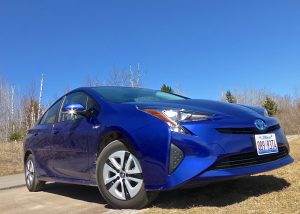
Prius styling has come a long way in its rise to icon status in Toyota’s fleet, which now includes even the Avalon.
By John Gilbert
The word “hybrid” seems like it should be considered the second half of a hyphenated phrase, with the first half, of course, being “Toyota.” As in “Toyota Hybrid.”
Other companies make hybrids., Some are excellent and break down barriers of new technology in the world of combining gasoline engines and electric motors. But Toyota, with its Prius, has established such a beachhead that some observers claim the Prius is Toyota’s new signature vehicle, replacing the ubiquitous Camry, and the RAV4 as the vehicle that best-defines Toyota.
But Toyota is hardly sitting still. Virtually everything the company makes has a hybrid version these days, from large sedans to compacts to SUVs. I recently had the chance to test drive two Toyota hybrids, and they are so different it seemed that combining them would describe the scope of Toyota’s hybrid reach.
First is the Toyota Avalon Hybrid, which takes Toyota’s unique luxury sedan and inserts its Hybrid Synergy Drive. At $39,789, we know that this is nobody’s Prius, because the compact Prius models — and there are three of them, these days — are priced between $20,000 and $30,000.
The Avalon began life back in the days when Toyota had expanded to form the Lexus luxury line, and the basic Lexus ES was basically a Camry all gussied up with fancy equipment as an entry-luxury level car. The first Avalon was pretty much the same thing, which prompted me to ask a Toyota executive why Toyota would build the Avalon, when it was so similar to the Lexus ES.
The explanation made perfect sense. A lot of Toyota buyers love their cars, but as they move up in station, they think buying a Lexus is pretentious, he said. So building the Avalon means those buyers can get their luxury and stay in the Toyota family.
A year ago, Toyota put a new body on the Avalon and made it much more than a fancy Camry. In fact, it gave Avalon the new stuff before Camry got it. Going to the hybrid model was a giant step, in a couple of ways. First, the styling calls for a larger and more dramatic lower grille, under the front bumper. The design is engineering oriented, but the stylists had to be excited, because the hybrid looks like the sporty Avalon.
When it came out, I declared the Avalon the best-looking sedan Toyota had ever made, and I stand by that claim. The Avalon Hybrid just looks a tad better.
Inside, it has all the luxury features any Lexus buyer might appreciate, and there is good reason the car performs and handles in a sportier fashion. The regular Avalon comes with a 3.5-liter V6, while the Hybrid comes with a 2.5-liter 4-cylinder and the battery-pack system with electric motors, boosting total power to 200 horsepower, running through front-wheel drive.
With revised suspension, the Avalon Hybrid corners well and handles, overall, like a sports sedan wearing luxury-car equipment. Included are all the latest safety and comfort features, like pre-collision and pedestrian detection, lane departure alert with steering assist, dynamic radar cruise control, automatic high beams, rear-view camera, electronic brake distribution and smart-stop technology.
Leather interior appointments and a 7-inch touch-screen, plus all the connectivity available, fill out the reasons for the Avalon Hybrid’s price tag. At that, it is a bargain, because with all the safety features the Avalon Hybrid at just under $40,000 delivers all the comfort you could want front and rear, plus 40 miles per gallon in town and 39 on the highway.
The new Prius line is just that — a. There are three models, the basic Prius, then the Prius C, and the Prius V.The model I test drove was the Prius Two Eco, which is a trim level that comes equipped to get optimum fuel economy. It has a larger battery pack, an 8.8 kW-hr lithium-ion battery compared to the heavier nickel-metal-hydride battery that was traditional in Prius models. A plug-in variation is also available.
The Prius takes Toyota’s 1.8-liter 4-cylinder and adds the electric complement for Toyota Synergy Drive. In that system, the power from the gasoline engine augments the electric motor power from the battery pack, and, in fact, comes on whenever the battery runs down, or when stepping harder on the gas demands maximum power.
The gas engine’s power, curiously enough, powers the generator which operates the wheels, meaning that the gas engine alone will not move the car. In all, the gas-electric combination offers 121 horsepower with — like the Avalon Hybrid — a CVT (continuously variable transmission) making the front wheels go.
While the Prius has an all-new look from a stylish redesign for 2017, it is priced at $26,544, and offers 58 miles per gallon in city driving, and 53 on the highway. The reason is that Toyota’s hybrid system works more efficiently in the stop and go driving in town than it does at sustained highway speed.
Naturally, the Prius doesn’t approach the Avalon’s luxury and comfort, but it offers a neat interior with instruments that let you trace your fuel-efficiency, and the seats are comfortable and supportive.
Handling is good, and the electric power boost gives the Prius surprisingly good acceleration, even with the CVT. The Bluetooth and other connectivity equipment is all in place, and enough of the costlier car’s features are installed on the Prius to make it well worth the sticker price.
The new model looks like a costlier alternative. In the Prius line, the more compact Prius C, the smallest member of the Prius family with a smaller 1.5-liter 4-cylinder, starting at a mere $21,000. The Prius V is longer and taller, almost like a wagon version, with a higher price tag closer to $30,000, and more power from the 1.8 and its battery unit, but its fuel economy drops to about 43 by EPA estimate for carrying the extra weight, and, presumably, extra cargo.
My pick is still the redesigned Prius Eco, and while it might surprise with its fun-to-drive approach while delivering its 58 mpg, it might make the perfect combination for an aspiring suburban family. If it is an affluent family, it would look perfect parked in that driveway next to the Avalon Hybrid.
Ioniq gives Hyundai advanced EV and hybrid
Filed under: Equinox, Autos
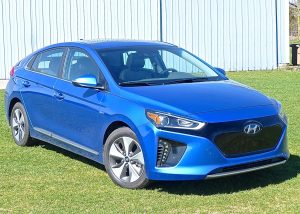
Ioniq offers stylish body on dedicated platform with buyers’ choice of pure electric, hybrid, or plug-in hybrid power.
By John Gilbert
ANN ARBOR, MI.
If the Hyundai Ioniq came out as a stylish new compact car, its sleek and aerodynamic looks, roomy interior, quick and agile performance, and smooth ride would undoubtedly make it a big hit at a base price of $22,200.
But it’s not a mainstream car. Far from it. It has all those above attributes, but it becomes a truly unique vehicle by being offered in a choice of three alternative powertrains. After a brief chance to aggressively road-test two of the Ioniq models, the impression it leaves is — in a word — electrifying.
I asked Hyundai officials if we were all going to be driving electric cars in the near future, or are hybrids a viable alternative. The consensus is that we are headed for electric-powered cars, but it will be a number of years before they take hold, which means hybrids and plug-in hybrids might make the most sense right now. Taking no chances, Hyundai is offering all three alternative powertrains in the new Ioniq.
Apprehensions from preconceived ideas can get in the way of buying a hybrid vehicle, much less a pure-electric one, and while Hyundai officials are aware of all the reasons buyers have for not buying such an alternative-energy car, they have designed the Ioniq to conquer all of them.
The Ioniq is the first car with a dedicated platform — shared with the new Elantra — designed to offer the choice of the most efficient hybrid in the industry, the most progressive plug-in hybrid in the industry, or the most environmentally sound and efficient pure-electric car in the industry.
That’s a lot of firsts, but ever since Hyundai made technical breakthroughs in engine, fuel injection, transmission efficiency, and design development nearly a decade ago, we shouldn’t be surprised by what those creative engineers in Seoul, South Korea, might come up with.
“The best thing is it looks like a regular car, and it drives like a regular car,” said Mike O’Brien, vice president of products for Hyundai Motors America.
I beg to differ. When my driving partner and I took off on the twisty and not always smooth roadways near Ann Arbor, we drove the Ioniqs harder than a normal citizen might drive. We wanted to push the Ioniq to see if it was just another alternative-energy car or truly something special. My vote was the latter.
If I there was a conventional engine under the hood, I would have been impressed that the Ioniq swept around tight, even blind, curves, always with the car following dutifully and with precision to all steering inputs. The fact that it was pure electric made it all the more impressive when it stayed level, never lurched, and handled the numerous road irregularities we flew across with nary a hint of harshness, looking high-style from every angle.
When my turn was finished, I found the passenger bucket seat supportive and comfortable in all circumstances, and it gave me a better chance to admire the smooth and high-end look and feel to the seats, dashboard and numerous features. They use wood chips and bits of volcanic rock to make the soft and supple top on the dashboard, for example. And they found a way to mix soybean oil into the paint, as another example of making the car sustainable.
The basic Ioniq Hybrid starts at a mere $23,000 including destination, its 1.6 engine helping recharge the battery pack. The plug-in Hybrid next up the scale, while the top-end, pure-electric version starts at $29,500. The EV will have no gas-engine safety net, but it will have a range of 124 miles before needing a recharge. It has a larger electric motor system, and a potent version of the LG Chem battery pack that develops 88 kW, the equivalent of 118 horsepower and 218 foot-pounds of torque, which collaborate to send the car rocketing away from a stop with startling potency.
There are other dazzling EVs newly on the market, such as the Tesla, the Chevrolet Bolt, Nissan Leaf, and BMW i3. The Bolt has a range of 238 miles, which is very impressive, and the Tesla also has excellent range. O’Brien, however, referred to industry standards for thermal efficiency, which take into account such things as the carbon footprint. Since 67 percent of our electric energy comes from fossil fuel or coal, the reality is that electric power may seem free, but nothing is free.
“Ultimately, we’re going to have to reduce our carbon footprint,” O’Brien said. “They call it an ‘MPGe’ equivalent, and by that calculation the Ioniq is the most efficient EV with a 136 MPGe, which beats the i3, the Bolt, and all other EVs on the market.”
O’Brien explained the assets of the three-pronged answer to all the alternative-energy challenges by first enumerating the challenges.
“While hybrid and electric vehicles have been around for awhile, it’s still a fact that 97 percent of buyers have not bought them,” said O’Brien. “That means only 3 percent are choosing hybrids or electric vehicles. We seem to be stuck on that number. The reasons consumers give for avoiding hybrids are: cost, lack of performance, boring, maintenance worries, not sporty enough, and insufficient passenger or cargo room.
“When you look under the hood of a Camry or Accord hybrid, you see all kinds of extra space, because the platform was designed for a larger engine. With a dedicated platform, and using a small engine with the hybrid, means we didn’t need all that space. So we moved the cowl forward, reducing the size of the engine compartment, and creating a much more spacious interior. Our hybrid has a total interior volume of 122.7 cubic feet, and our plug-in hybrid and EV have 120 cubic feet.”
In addition, Hyundai worked with LG Chem, the South Korean electronics giant that designed and built the battery pack for the Chevrolet Volt, and the new Chevrolet Bolt pure-electric, as well as for Hyundai, Kia and other hybrid car-makers. The streamlined design of the battery pack, with vertical plates, and a lithium ion polymer structure, make it lighter and smaller and able to be form-fit into odd areas. And lithium-ion-polymer battery packs generate more power, hold the charge longer, and recharge more quickly.
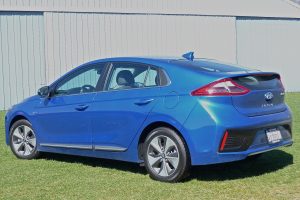
Battery pack location under rear seat provides mid-car weight balance, full 122.7 cubic feet of cargo space.
Other hybrid car-makers fit the battery pack under the trunk, which greatly cuts down the cargo room, and, being heavy, gives most hybrids an odd weight-distribution. Hyundai engineers designed the Ioniq with the battery pack under the rear seat, leaving full trunk space, and creating a lower center of gravity and a mid-engine feel that enhances steering and contributes to good handling.
Hyundai engineers also revised their well-proven 1.6-liter Kappa 4-cylinder, a dual-overhead-camshaft gem with direct injection that can make compact cars, midsize cars, and even the Tucson compact SUV perform admirably, with a turbocharger in some cases. In the Ioniq, it is altered with Atkinson-cycle technology that keeps the intake valves closed a bit longer, and delays the opening of the exhaust valves. That allows the air-fuel mixture more time to more fully ignite, resulting in greater thermal efficiency, and extra power. With the hybrid, the engine doesn’t need extra power, because the electric motor supplements any need for power.
In the Ioniq Hybrid, the 1.6 has 104 horsepower at a high 5,700 RPMs, and 109 foot-pounds of torque at 4,000 RPMs. The electric motor adds 32 kW (43 horsepower) for a 125 horsepower maximum, and its 125 maximum added torque combines for a 139 foot-pound punch.
The biggest surprise to many traditionalists is that electric motor power is more efficient than a gas engine. It has 100 percent of its torque at zero RPMs, so stepping hard on an electric car’s “gas” pedal can snap your head back by surprise. In the Ioniq Hybrid, the electric motor’s instant torque aids low-end power, and if you need extra power at high speed, the electric power can continue to supplement the 4-cylinder up to 75 miles per hour.
After being thoroughly impressed with the pure-electric Ioniq, we also drove the base-model hybrid, which also drove well, with quick acceleration, and good steering and handling. Unlike nearly all other hybrids, the Ioniq Hybrid does not use a CVT, the continuously variable transmission that uses belts and pulleys to seamlessly shift, but leaves the unsatisfying feeling of “motorboating” instead of tangible shift points.
Hyundai engineers equipped the Ioniq with their own 6-speed dual-clutch transmission that shifts swiftly and with a decisive sportiness, whether you like paddles or just switching to “sport” to hold shift points higher. The “eco” setting upshifts earlier for better economy, and the Ioniq Hybrid comes away with everyday fuel economy of 59 highway, and 58 mpg combined city-highway. That beats the Prius and all other hybrids, as does the Ioniq’s thermal efficiency that means 40 percent of all its energy goes to its wheels, which are shod with specially designed Michelin tires.
We didn’t get to drive the plug-in hybrid, which is yet to be introduced as the third electrified system. That will move up from the Hybrid’s 32 kWh with 43 horsepower, to 45 kWh, and 60 horsepower. With more electric motor power in the mix, when fully charged it will go 27 miles on electric only, before the gas engine kicks in seamlessly to help.
Both hybrids share the 6-speed dual-clutch transmission. The plug-in Hybrid has a more powerful charger. You can connect to normal household outlets, but if you use the quick-charge system you can recover 80 percent of a full charge in 23 minutes, a fast charge that will let you cover another 99 miles.
All available safety items, including standard rear camera, and the availability of lane-change devices, are included, and the Ioniq also has all the latest in connectivity features.
I am eager for a longer test-drive, but the first impression will be hard to shake. The Ioniq beats the tests of cost, sportiness, being not boring, being not sporty, and having insufficient interior room.
If maintenance worries still exist as the last concern, how about this: Along with Hyundai’s usual 10-year, 100,000-mile engine warranty, there is a lifetime warranty on the battery pack.
I kidded O’Brien that if the Ioniq doesn’t quite meet fuel-efficiency figures, they could come out with a Type R and insert a tiny “R” between the “I” and the “O” to make it an “Ironiq.” He didn’t laugh. After driving the car, I’m more inclined to suggest they might need to insert a small “C,” because the new car could indeed become Iconiq.



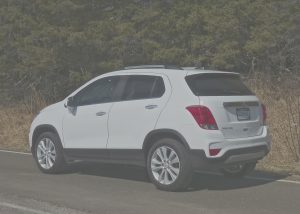
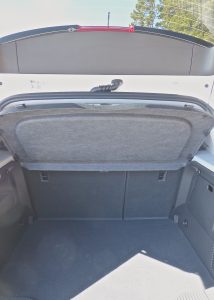
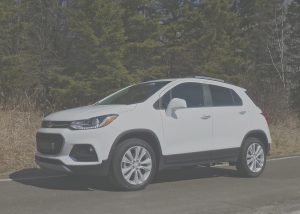
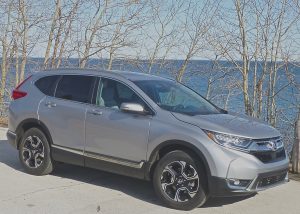

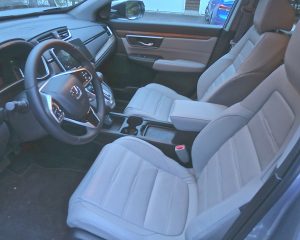

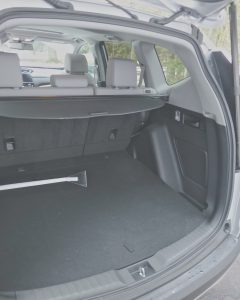
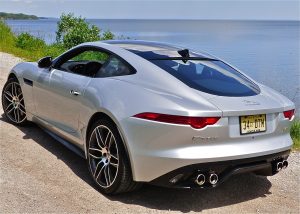




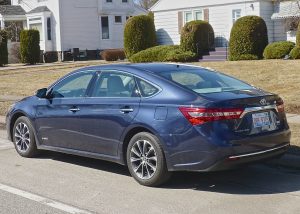

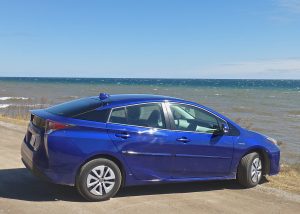
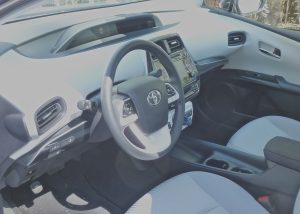

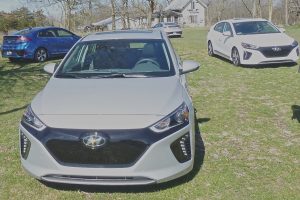
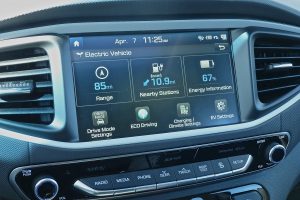
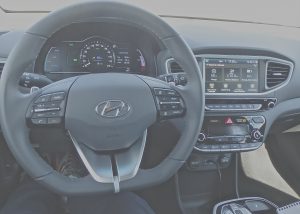
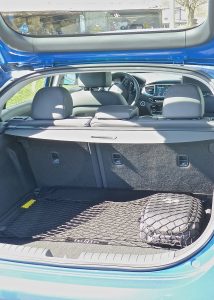
 John Gilbert is a lifetime Minnesotan and career journalist, specializing in cars and sports during and since spending 30 years at the Minneapolis Tribune, now the Star Tribune. More recently, he has continued translating the high-tech world of autos and sharing his passionate insights as a freelance writer/photographer/broadcaster. A member of the prestigious North American Car and Truck of the Year jury since 1993. John can be heard Monday-Friday from 9-11am on 610 KDAL(www.kdal610.com) on the "John Gilbert Show," and writes a column in the Duluth Reader.
John Gilbert is a lifetime Minnesotan and career journalist, specializing in cars and sports during and since spending 30 years at the Minneapolis Tribune, now the Star Tribune. More recently, he has continued translating the high-tech world of autos and sharing his passionate insights as a freelance writer/photographer/broadcaster. A member of the prestigious North American Car and Truck of the Year jury since 1993. John can be heard Monday-Friday from 9-11am on 610 KDAL(www.kdal610.com) on the "John Gilbert Show," and writes a column in the Duluth Reader.